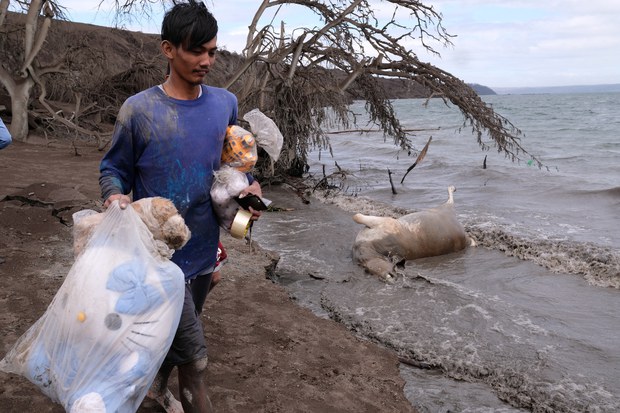Thousands Return Home after Philippine Volcano Quiets Down
2020.01.27
Manila
 A man walks past the bloated cadaver of an animal while retrieving stuffed animals and salvaging materials from his ruined home on Taal Volcano island, Jan. 14, 2020.
A man walks past the bloated cadaver of an animal while retrieving stuffed animals and salvaging materials from his ruined home on Taal Volcano island, Jan. 14, 2020.
Tens of thousands of displaced villagers began returning home Monday after Philippine authorities lowered the alert on Taal volcano, which appeared to have calmed down after two weeks of spewing ash and molten rock.
The Philippine Institute of Volcanology and Seismology (Phivolcs) brought down the alert level around Taal’s main crater from four to three on Sunday, although white steam-laden fumes were still visible during the past 24 hours. The five-step alert’s level 5 would indicate a major eruption.
But Phivolcs warned on Monday that “sudden steam-driven and even weak phreatomagmatic explosions, volcanic earthquakes, ashfall and lethal volcanic gas expulsions can still occur.”
The postcard-perfect volcano on an island in a lake in Batangas province, about 100 km (62 miles) south of Manila, erupted on Jan. 12, raining ash across the islands, including in Manila and causing the capital’s main airport to cancel dozens of flights. Tens of thousands were evacuated, but there were no immediate reports of deaths among villagers.
As they lowered the alert level on Sunday, authorities also agreed to allow residents in affected areas to return home, except for the municipalities of Laurel and Agoncillo, two areas that bore the brunt of the massive ashfall two weeks ago.
In the days after the volcano began rumbling, the coast guard struggled to keep residents away from the affected towns despite orders to cordon off the island.
Dozens of residents on boats crossed over to salvage materials from their homes and many local officials angrily confronted the police as they ignored warnings not to enter their towns during the past two weeks.
Ricardo Jalad, who heads the government’s disaster-response agency, told reporters Monday that more than 390,000 people had been affected by the disaster. Thousands were still being served in evacuation centers or were staying with their relatives, he said.
Emergency crews were continuing to clear at least eight road networks of debris, with thick ash still covering many areas, Jalad said, adding that the provinces of Cavite and Batangas remain in a state of calamity.
Thousands of children would likely camp out in evacuation centers with their families for weeks or months, according to the international aid group Save the Children.
“Being made homeless puts these children at serious risk of abuse and exploitation,” Jerome Balinton, humanitarian manager for the group, told reporters Monday.
Ciriaco Santiago, a member of a community of priests and lay brothers who run a shelter in Lipa city, told BenarNews that dozens of villagers who had sought refuge there had gone home after the alert was lowered Sunday.
But about 145 people from the heavily affected towns of Agoncillo and Lemery had opted to stay with them until this week, Santiago said.
“But we are continuing our feeding mission at different places that are still in the disaster zone,” he said.
![200127-PH-taal-620INSID.jpg Taal Volcano as seen from a canoe, Jan. 14, 2020. [Jason Gutierrez/BenarNews]](/english/news/philippine/philippines-volcano-01272020124503.html/200127-PH-taal-620INSID.jpg/@@images/9b954399-a6fe-4ace-adf4-7a97ab1368e1.jpeg)







